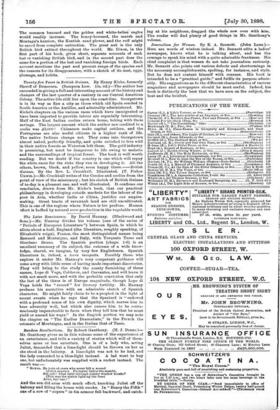Lost and Vanishing Birds. By Charles Dixon. (J. Macqueen. 7s.
6d.)—Mr. Dixon's book is a plea for the protection of wild birds. He points out in his introduction that in some places it is partly the growth of civilisation and the reclamation of waste lands which have led to the extermination of birds such as Savi's warbler and the spoonbill. Yet there are other species which owe their lessening numbers solely to the direct persecution of man. He says : " We cannot recall to mind a solitary instance in which the extermination of a species within historic times has been exclusively due to any extra-human agency." Un- civilised man with his rude weapons makes little impres- sion upon continental faunm, but in these days the march of civilisation is depopulating even the biggest continents of their larger and more helpless animals. Islands, however, suffer far more quickly, owing to the limited numbers composing each species, and the peculiar and local circumstances of their existence, which make them sensitive to adverse influences. The British Islands, which are in proximity to, and in constant com- munication through normal migration with, large areas of land of which they were once a part, are less liable to the extermina- tion of species than islands like New Zealand, which have been long in a state of isolation. These last develop a fauna peculiar to themselves, such as the moas and other wingless birds, and have no place from which to replenish their numbers. In the British Isles there are but two peculiar species ; one, the red grouse, is preserved for the sake of the sport it affords ; the other. the St. Kilda wren, which Mr. Dixon's partiality as its discoverer makes into a separate species from the common wren, is in danger of complete extermination. Many other British birds, especially local species, such as the Dartford warbler, the though, the bearded titmouse, the red-necked phalarope, and the roseate tern, are in like danger. Mr. Dixon has no hope that birds like the crane, the avocet, the black-tailed godwit, and the black tern, which formerly bred here and are now only occasional visitors, will ever return as breeding species, though the bittern and the great bustard might perhaps, like the capercaillie, be reinstated by man. But, for other species protection might do much. The hoopoe and the golden oriole would certainly breed regularly in Great Britain. The osprey, the kite, the hen-harrier, and the dotterel would probably increase their nesting places.
The common buzzard and the golden and white-tailed eagles would readily increase. The honey-buzzard, the marsh and Montage's harriers, the Kentish sand plover, and the ruff might be saved from complete extinction. The great auk is the only British bird extinct throughout the world. Mr. Dixon, in the first part of his book, gives short, separate accounts of each lost or vanishing British bird, and in the second part does the same for a portion of the lost and vanishing foreign birds. Each account mentions the past and present range of the species and the reasons for its disappearance, with a sketch of its nest, eggs, plumage, and habits.



































 Previous page
Previous page